villa la camargue
Main menu
cities and art
Gaeta: the name of the city comes from Cajeta, the nurse of Aeneas. Strabo refers to the name of the large bay of the gulf. Gaeta has ancient origins and a long and varied history. The roman and medieval remains, with the Bourbon strongholds, recall the moments of splendor of the city. Gaeta, a place so beautiful and so interesting, was coveted by all those who have played an important role in history.


the Angevin-

Cathedral of St. Erasmo century VII; century X; century XVIII -

church of St. Francesco: The convent was founded by St. Francesco in 1222. the largest Gothic church was completed in the fourteenth century. Like all other major churches of Gaeta, was enriched with works of art from the sixteenth to the eighteenth century.


the dome of the church "s.giovanni a mare" rare and precious example of Romanesque architecture in which the pattern of the basilica blends well with that of the Byzantine church. the building dates back probably around the twelfth century.

SS Annunziata church, originally a Gothic style, it stands as a magnificent example of Baroque architecture. renovated in 1621, three hundred years after its foundation, inside, the great sixteenth-

Montagna spaccata and the cave of turkish: it is said that a sailor turkish disbeliever refused to believe that the mountain opened in the same time of death of Jesus , for contempt put his hand to the rock and the rock miraculously rammolí and remained the 'imprint of his hand.



Mausoleum of Lucius Munatius Planco is located in Gaeta on top of the Monte Orlando. It is the tomb of Lucius Munatius Planco, the Roman consul who wanted to build his house on the hill and your grave in a dominant position and protected from the rest of the city



Sperlonga: according to tradition at Sperlonga stood the city of Amyclae, founded by Spartans

during the Roman era were built numerous villas, the most famous is the one belonging to the emperor Tiberius, where they were found important sculptures, including the remains of some famous plastic groups such as Scilla that attacked the ship of Ulysses and Polyphemus blinded belonging to the school rodia the end of the century. II. C




Formia: place for the ruling class of Rome. The archaeological evidence allows us to date around the second-



